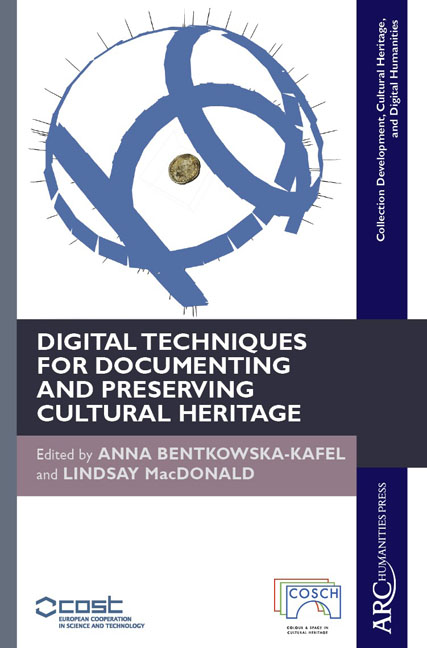Multiple View Stereovision
Published online by Cambridge University Press: 26 January 2021
Summary
COSCH Case Study that has applied this technology: Kantharos
Definition
Multiple view, or multi-view stereo vision is the process of reconstructing the 3D model of an object, or scene, from a set of digital images. This 3D model may be generated in several kinds of representation, for example, as a point cloud, as a photo-textured surface, or even as an orthophotograph.
Description
Stereo vision is necessary in the 3D recording of cultural heritage, as it provides accuracy, completeness, and visual quality, as well as cost effectiveness. Thus it plays an important role in the documentation, restoration, preservation, and promotion of cultural heritage assets. Multi-view vision applications may range from small artefacts to large geographic regions by exploiting any kind of optical camera (e.g., SLR, compact, mobile phone) and supporting system (e.g., trolleys, cars, UAVs, robots). Currently, many commercial software and open source algorithms exist for multiple view stereovision; some of these are more generic, others are more application specific. Although such software implementations have brought the 3D product to the public, for more demanding applications the expertise of a professional is still required.
The term multiple view stereovision refers to the automatic reconstruction of a 3D object, or scene (i.e., estimation of 3D coordinates) from more than two source images. Strictly speaking, it could be viewed as essentially an ill-posed 2D-to-3D problem, meaning that the solution is not trivial. This process may involve an arbitrary number of images with different characteristics (positions, rotations, internal camera parameters) from different cameras (still or video frames). The scenes are assumed to be static, thus moving objects are treated as outliers; a different class of methods has been evolved to treat moving and deformable objects.
Model reconstruction from multiple views consists of two main steps: sparse reconstruction and dense reconstruction, while in some cases it can also involve a texture-mapping step. Typically, the process begins with the extraction of interest points, but line or area features may also be exploited. For extracted image points, appropriate characteristic descriptors are calculated, and the point correspondences among images are established via some similarity measure. The retrieved correspondences are used in the bundle adjustment procedure, to restore simultaneously the image orientations (i.e., position and rotations). The Structure from Motion (SfM) process can also provide the camera calibration in multi-view stereo vision.
- Type
- Chapter
- Information
- Publisher: Amsterdam University PressPrint publication year: 2018



